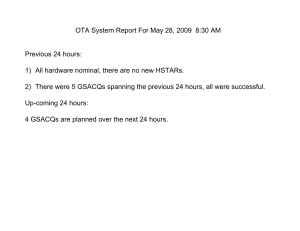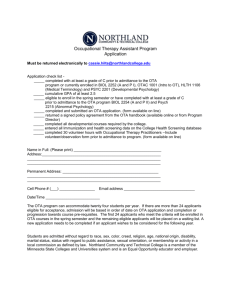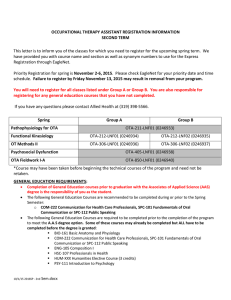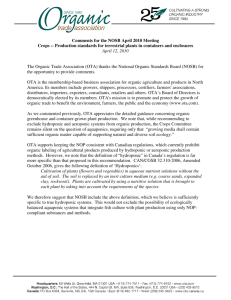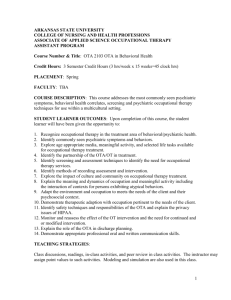British Journal of Pharmacology and Toxicology 4(3): 101-105, 2013
advertisement
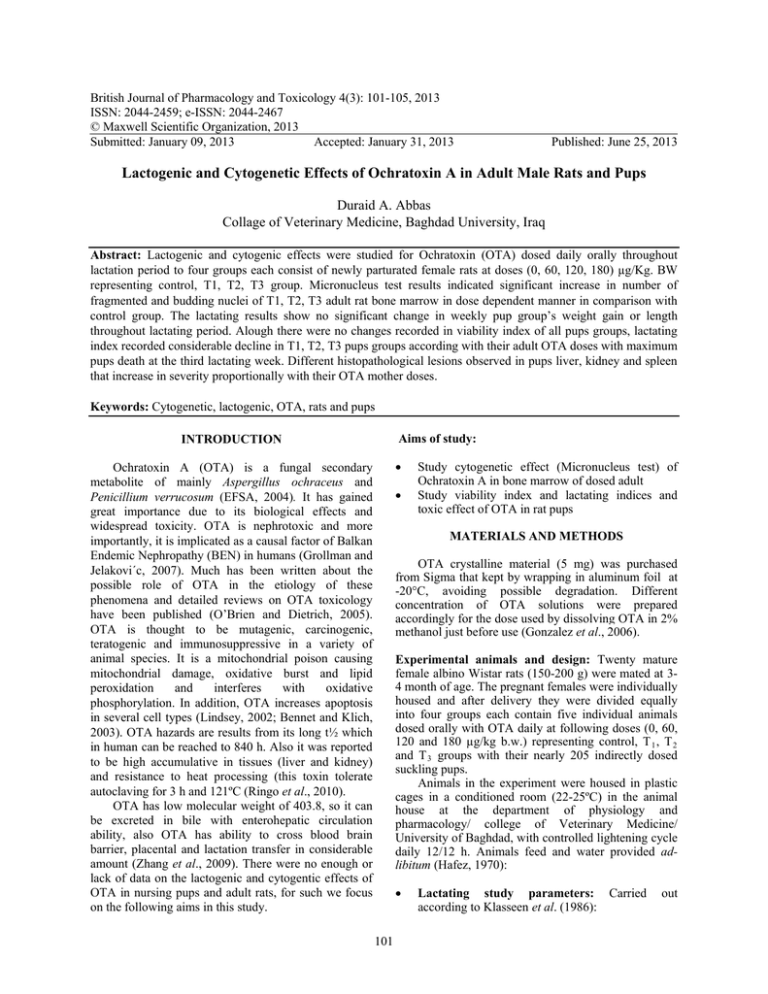
British Journal of Pharmacology and Toxicology 4(3): 101-105, 2013 ISSN: 2044-2459; e-ISSN: 2044-2467 © Maxwell Scientific Organization, 2013 Submitted: January 09, 2013 Accepted: January 31, 2013 Published: June 25, 2013 Lactogenic and Cytogenetic Effects of Ochratoxin A in Adult Male Rats and Pups Duraid A. Abbas Collage of Veterinary Medicine, Baghdad University, Iraq Abstract: Lactogenic and cytogenic effects were studied for Ochratoxin (OTA) dosed daily orally throughout lactation period to four groups each consist of newly parturated female rats at doses (0, 60, 120, 180) µg/Kg. BW representing control, T1, T2, T3 group. Micronucleus test results indicated significant increase in number of fragmented and budding nuclei of T1, T2, T3 adult rat bone marrow in dose dependent manner in comparison with control group. The lactating results show no significant change in weekly pup group’s weight gain or length throughout lactating period. Alough there were no changes recorded in viability index of all pups groups, lactating index recorded considerable decline in T1, T2, T3 pups groups according with their adult OTA doses with maximum pups death at the third lactating week. Different histopathological lesions observed in pups liver, kidney and spleen that increase in severity proportionally with their OTA mother doses. Keywords: Cytogenetic, lactogenic, OTA, rats and pups Aims of study: INTRODUCTION • Ochratoxin A (OTA) is a fungal secondary metabolite of mainly Aspergillus ochraceus and Penicillium verrucosum (EFSA, 2004). It has gained great importance due to its biological effects and widespread toxicity. OTA is nephrotoxic and more importantly, it is implicated as a causal factor of Balkan Endemic Nephropathy (BEN) in humans (Grollman and Jelakovi´c, 2007). Much has been written about the possible role of OTA in the etiology of these phenomena and detailed reviews on OTA toxicology have been published (O’Brien and Dietrich, 2005). OTA is thought to be mutagenic, carcinogenic, teratogenic and immunosuppressive in a variety of animal species. It is a mitochondrial poison causing mitochondrial damage, oxidative burst and lipid peroxidation and interferes with oxidative phosphorylation. In addition, OTA increases apoptosis in several cell types (Lindsey, 2002; Bennet and Klich, 2003). OTA hazards are results from its long t½ which in human can be reached to 840 h. Also it was reported to be high accumulative in tissues (liver and kidney) and resistance to heat processing (this toxin tolerate autoclaving for 3 h and 121ºC (Ringo et al., 2010). OTA has low molecular weight of 403.8, so it can be excreted in bile with enterohepatic circulation ability, also OTA has ability to cross blood brain barrier, placental and lactation transfer in considerable amount (Zhang et al., 2009). There were no enough or lack of data on the lactogenic and cytogentic effects of OTA in nursing pups and adult rats, for such we focus on the following aims in this study. 1T 3T1 • Study cytogenetic effect (Micronucleus test) of Ochratoxin A in bone marrow of dosed adult Study viability index and lactating indices and toxic effect of OTA in rat pups MATERIALS AND METHODS OTA crystalline material (5 mg) was purchased from Sigma that kept by wrapping in aluminum foil at -20°C, avoiding possible degradation. Different concentration of OTA solutions were prepared accordingly for the dose used by dissolving OTA in 2% methanol just before use (Gonzalez et al., 2006). Experimental animals and design: Twenty mature female albino Wistar rats (150-200 g) were mated at 34 month of age. The pregnant females were individually housed and after delivery they were divided equally into four groups each contain five individual animals dosed orally with OTA daily at following doses (0, 60, 120 and 180 µg/kg b.w.) representing control, T 1 , T 2 and T 3 groups with their nearly 205 indirectly dosed suckling pups. Animals in the experiment were housed in plastic cages in a conditioned room (22-25ºC) in the animal house at the department of physiology and pharmacology/ college of Veterinary Medicine/ University of Baghdad, with controlled lightening cycle daily 12/12 h. Animals feed and water provided adlibitum (Hafez, 1970): 3T R R • 101 R R R R Lactating study parameters: Carried according to Klasseen et al. (1986): out Br. J. Pharmacol. Toxicol., 4(3): 101-105, 2013 Table 1: Body weight change (g/week) of rats pups at end of lactation period for nursing dams dosed daily and orally with OTA Period ---------------------------------------------------------------------------------------------------------------------------------------Group Zero time After 7 days After 14 days After 21 days Control 6.15±0.32Aa 11.00±0.66Ab 17.20±0.58Ac 25.15±1.52Ad T1 60 µg/Kg 5.71±0.20Aa 10.20±0.88Ab 16.66±1.43Ac 25.96±2.14Ad T2 120 µg/Kg 5.80±0.20Aa 11.75±0.56Ab 18.72±1.43Ac 26.39±2.71Ad T3 180 µg/Kg 5.56±0.21Aa 11.65±0.48Ab 17.88±0.80Ac 25.84±1.01Ad LSD: 1.35; Values represent mean±S.E.; Different capital letters mean significant (p<0.05) results between different concentration; Different small letters mean significant (p<0.05) results between periods o o o Weights of one day old neonates as well as their lengths measured according to the crown hump method. Suckling pups weights and lengths changes weekly during lactation period. Number of dead and life neonates during the four days of age (viability index) which is the percentage of pups survive till four days after birth: Viability index = (Number of neonates till four days of age/Total number of neonates) ×100 Fig. 1: Rat's pups at the end of lactation period for nursing dams dosed daily orally with OTA at different doses 1T 1T o Survival ability through lactation period (lactating index), which is the percentage of suckling pups still alive from the day 4th of age till the day 21 of lactation. P treated adult rats and their pups. The data were expressed as Mean±Standard Errors (S.E.) and pvalue<0.05 was considered statistically significance. LSD was carried out to test the significance levels among means of treatments (Joda, 2008). 1T P 1T Lactating Index = (Number of surviedl pups from the day 5-21days/Total number of remaining pups during 5-21 days) ×100 • RESULTS Pups rats body weight change: The result of body weight change (g/week) in pups rats showed no significant change at (p<0.05) between the treated T1, T2 and T3 groups and between each and control group at zero time, 7, 14 and 21 days of lactation period to dams dosed orally with ochratoxin A for 21 days during lactation. Between period result indicate significant increase in body weight at (p<0.05) for each control and treated groups positively related with the time, Table 1 and Fig. 1. Cytogenetic study (micronucleus test): At the end of lactation period adult female's dam of different experimental groups sacrificed by heart puncture. The femur was exposed and dissected, the two ends were cut and bone marrow was collected by injection 1 mL of fetal calf serum. Smear of bone marrow precipitates were stained with Giemsa stain and examined under oil emersion lens. Percent of micronuclei in 500 Ploychromatic Erythrocyte (PCE) were recorded according to Schimd (1979). Pups rats length: The result of body length change (cm/week) in pups rats showed no significant change at (p<0.05) between the treated T1, T2 and T3 groups and between each and control group at zero time, 7, 14 and 21 days of lactation period to dams dosed orally with ochratoxin A for 21 days during lactation. Between period result indicate significant increase in body length at (p<0.05) for each control and treated groups positively collated relationship with the time, Table 2, Fig. 1. Histopathological preparations and examination: After scarification of different pups groups at the end of lactation. Specimens of their livers, kidneys and spleens were fixed by 10% neutral buffered formalin solution till the preparation of histological sections. Tissues were embedded in paraffin and several tissue sections were prepared for histopathological examination after staining with Hematoxylin-Eosin (H and E) Stain (Luna and Lee, 1968). Viability index: The result of viability index in pups of T3 group showed death of one pup (97.91%) in the 4th day of lactation while other groups did not showed any mortality in their pups in comparison with control one throughout lactation period for nursing dams dosed orally and daily with OTA, Table 3. Statistical analysis: Statistical analysis of the experimental results were conducted according to Statistical Package for the Social Sciences (SPSS) version 13.00 where one way ANOVA was used to assess the significance of changes between control and P 1T 102 P Br. J. Pharmacol. Toxicol., 4(3): 101-105, 2013 Table 2: Body weight change (g/week) of rats pups at end of lactation period for nursing dams dosed daily orally with OTA at different doses Period -----------------------------------------------------------------------------------------------------------------------------------------Group Zero time After 7 days After 14 days After 21 days Control 4.34±0.09Aa 5.00±0.14Ab 5.68±0.22Ac 7.22±0.20Ad Aa A Ac 60 µg/Kg 4.33±0.05 5.26±1.05 5.95±0.18 7.21±0.35Ad 120 µg/Kg 4.40±0.07Aa 5.08±0.27A 5.98±0.31Ac 7.26±0.30Ad 180 µg/Kg 4.27±0.11Aa 5.13±0.07A 5.06±0.31Ac 7.16±0.14Ad LSD groups and periods: 0.52; Values represent mean±S.E.; Different capital letters mean significant (p<0.05) results between different concentration; Different small letters mean significant (p<0.05) results between periods Table 3: Viability index of rat pups through lactation period for nursing dams dosed daily orally with OTA at different doses Dead off springs along first four days of age Total number of -------------------------------------------------------------------------------------------Groups off springs One day Two days Three days Four days Control 54 0 0 0 0 T1 (60 µg/Kg) 55 0 0 0 0 T2 (120 µg/Kg) 49 0 0 0 0 T3 (180 µg/Kg) 48 0 0 0 1 Viability index (%) 100 100 100 97.91 Table 4: Lactating index of rat pups through lactation period for nursing dams dosed daily orally with OTA at different doses Number of dead off springs/weekly Number of off springs after the day -------------------------------------------------------------------------------------Groups First week (5-7) days Second week Third week 4th of age Control 54 0 0 0 T1 60 µg/Kg 55 0 2 2 T2 120 µg/Kg 49 1 2 3 T3 180 µg/Kg 47 1 3 5 Lactating index (%) 100 92.72 89.79 80.85 P P Table 5: Micronucleus test (number of cells in micronucleus/500 bone marrow cells) for adult females rats dosed with different OTA oral doses for 20 days Group Mean of micronucleus Control 25.00±1.81A T1 60 µg/Kg 35.20±1.20B T2 120 µg/Kg 54.00±1.04C T3 180 µg/Kg 78.20±1.31D Values represent mean±S.E.; Different capital letters denote significant results (p<0.05) between different groups P P P P Fig. 3: Histopathological section of T1, T2 and T3 rat pups liver after 21 days of treatment with OTA doses showed (T1): Vacuolation of hepatocytes ( ) (T2): Few mononuclear cells aggregation around blood vessels ( ) (T3): Aggregation of macrophages ( ) nuclei of bone marrow cells between all treated groups T1, T2 and T3 accordingly with their doses after 21 days from administration of OTA and in comparison with the control group, Table 5, Fig. 2. Fig. 2: Micronucleus of adult female rats after exposure to different oral doses of Ochratoxin A. Normal cells ( ) fragmented nucleus ( ), budding cells ( ) (Giemsa stain, 100X) Histopathological study: Liver: T1 (60 µg/kg OTA): The main lesion characterized by congestion of central veins with vacuolation in the cytoplasm of hepatic cells. 0T Lactating index: The result showed increase in mortality rate of rats pups with a decreasing lactating index of all treated groups accordingly with their mother OTA doses in comparison with control one throughout lactation period. Lactation index recorded as 92.7, 89.8 and 80.8% for T1, T2 and T3 respectively in comparison with 100% for control suckling pups group, Table 4. T2 (120 µg/kg OTA): Main lesion similar to T1 but more severe lesion observe with few mononuclear cells aggregation around blood vessels. T3 (180 µg/kg OTA): Same but more severe lesion with aggregation of macrophages in the portal area around the blood vessels, Fig. 3. Cytogenetic study: The results of Micronucleus test in adult female dams treated groups showed a significant increase (p<0.05) in number of fragmented and budding Kidney: T1 (60 µg/kg OTA): Atrophy of glomerular tufts with dilation of bowman's capsule with mononuclear cells 103 Br. J. Pharmacol. Toxicol., 4(3): 101-105, 2013 lactation period after administration of their dams with OTA, this is may be resulted from short time of exposure and the low OTA dam doses but this not exclude its effect on pups survival during lactation accordingly with their dam doses since lactation index were decreased 10 and 20% in T2 and T3 respectively which indicate that the transferred OTA in milk in these groups induce physiological change and pathological lesion in important organs and tissues like brain, liver, spleen and kidney that confirmed by present histological results in organs of indirectly dosed suckling pups. All of these might lead to increase in mortality rate and decline in lactating index of pups groups accordingly with the OTA amount transferred in the milk of their dosed dams which were enough to overcome the low ability to metabolize in liver and excrete by the kidney or by hindering transport through BBB which reported to be not well developed in neonate and pups (Cornford et al., 1982). The lactating results recorded in the present study are in agreement with Hallen et al. (1998) who investigated the placental and lactation transfer of OTA to pups in cross fostering study in rats that showed OTA at 50 µg/kg did not result in any effects on birth weight or growth development of the pups during the first 21 days of life. In that study, the mean milk: blood ratio of approximately 0.6 was found. The dose of OTA from milk to the suckling pup at 14 days of age calculated to about 50 µg/kg body weight day, which is similar to the dose given to the dams. Pups exposed to OTA only via milk had blood and kidney levels of OTA approximately 3 times higher than their dams, indicating a high absorption and/or a low excretion of OTA in the suckling. At 14 days of age the highest blood and kidney levels of OTA were found in offspring exposed both via placenta and milk, with the highest contribution from milk. This may explain why lactating index showed higher ratio at 2nd and 3rd week in our present study. In other study conducted by Moré and Galtier (1975) on the effects of OTA on dam rats given 2.5 mg OTA/kg bw twice, the mean body weights in male and female offspring at 82 days were reduced by 12 and 8%, respectively. In 26% of male offspring of that group hydrocephalus was observed on day 15 after birth and 40% of these animals died by 20 days after birth. The micronucleus test result indicates the presence of nuclear genotoxicity in bone marrow cells positively proportional with OTA doses in different females treated groups. This result is in agreement with the finding of Al-Fatlawi (2012) who reported that different doses of OTA caused different chromosomal aberrations and increase in mitotic index in bone marrow cells of adult male rats in dose dependent manner. This may be attributed to the reported genotoxic effects resulted from the oxidative damage on DNA nucleotide bases by OTA in different in vivo and in vitro studies. Fig. 4: Histopathological section of T1, T2 and T3 rat pups kidney after 21 days of treatment with OTA doses showed (T1): Atrophy of glomerular tuff ( ) with a cute cellular degeneration in epithelial linning cells of renal tubular ( ) (T2): Mononuclear cells aggregation between renal tubules ( ). (H and E stain) 40X Fig. 5: Histopathological section of T1, T2 and T3 rat pups spleen after 21 days of treatment with OTA doses showed (T1): Muscular hyperatrophy ( ) with congestion of red pulp ( ) (T2): Hyperplasia of endothelial lining cells of central arteries ( ) with moderate hyperplasia of white pulp ( ) (T3): Mononuclear cells aggregation around blood vessels in portal area ( ) infiltration between the renal tubules together with the vacuolation, sloughing of epithelial lining cells in the renal tubules were seen. T2 (120 µg/kg OTA): Mononuclear aggregation around the blood vessels and renal tubules and other lesions were same as T1 but more severe. T3 (180 µg/kg OTA): Same as T1 and T2 but more severe lesion was observed, Fig. 4. Spleen: T1 (60 µg/kg OTA): Congestion of blood vessels and red pulps with mononuclear cells infiltration in their lumina were observed with hypertrophy of muscular layers. Congestion and hyperplasia of endothelial cells of central arterioles. T2 (120 µg/kg OTA): Main lesion similar to that observed in T1 together with hyperplasia of endothelial cells lining of central artery with hyperplasia of white pulp. T3 (180 µg/kg OTA): Same as T1 and T2 but more severe lesion was observed with more hyperplasia of white pulp, Fig. 5. DISCUSSION Our present study results of OTA recorded no body weight and length changes of rat pups at the end of 104 Br. J. Pharmacol. Toxicol., 4(3): 101-105, 2013 In cell culture, an OTA-dependent increase in DNA damage (such as formation of 8-oxoguanine) was correlated with the production of ROS (Schaaf et al., 2002; Kamp et al., 2005). Antioxidants were shown to prevent OTA-mediated increases in MDA production in vitro and in vivo (Baudrimont et al., 1997). In conclusion, the reported transfer of OTA in milk of dosed dams during lactation was at high level at the 2nd and 3rd week of lactation period in concentration more than their blood. This may be enough to induce oxidative changes and damage mainly in suckling pups parenchyma tissues like liver, kidney and spleen that are rich in mitochondrial oxidative activities by increasing production of ROS that overcome cellular antioxidant defense mechanism (Baudrimont et al., 1997). Hallen, I., L. Jorhem and A. Oskarsson, 1998. Placental and lactational transfer of Ochratoxin A in rats: A study on the lactational process and effects on offspring. Arch. Toxico., 69: 596-602. Joda, M., 2008. The Progressive Statistical Analysis by using SPSS. 1st Edn., Churchill Livingstone, Edinburgh. Kamp, H., G. Eisenbrand, C. Janzowski, J. Kiossev, J. Latendresse, J. Schlatter and R. Turesky, 2005. Ochratoxin A induces oxidative DNA damage in liver and kidney after oral dosing to rats. Mol. Nutr. Food Res., 49: 1160-1167. Klasseen, C.D., M.O. Amdur and M.D. Jhon-Doul, 1986. Cassarett and Doulls Toxicology: The Basic Science of Poisons. 3rd Edn., Macmillan Co., Inc., New York. Lindsey, H., 2002. Ochratoxin A may cause testicular cancer. Lancet Oncol., 3: 129-130. Luna, G.L. and A.A. Lee, 1968. Manual of Histological Staining Methods of the Armed Forces. Institute of Pathology. 3rd Edn., McGraw-Hill Book Company, New York, USA. Moré, J. and P. Galtier, 1975. Toxicity of ochratoxin A. II. Effects of treatment on the progeny (F1 and F2) of intoxicated rats. Ann. Rech. Vét., 6: 379-389. O’Brien, E. and D. Dietrich, 2005. Ochratoxin A: The continuing enigma. Crit. Rev. Toxicol., 35: 33-60. Ringo, D., S. Chango, J. Yves and Y. Larondelle, 2010. Toxicokinetics and toxicodynamics of Ochratoxin A, an update. Chemobiological. Interact., 159: 18-46. Schaaf, G., S. Nijmeijer, R. Maas, P. Roestenberg, E. de Groene and J. Fink-Gremmels, 2002. The role of oxidative stress in the Ochratoxin Amediated toxicity in proximal tubular cells. Biochim. Biophys. Acta Mol. Basis Dis., 1588(2): 149-158. Schimd, W., 1979. The Cell Micronucleus Test for Cytogenetic Analysis. In: Holaender, A. (Ed.), Chemical Mutagenes Principles and Methods for their Detection. Plenum Press, New York and London. Zhang, X., C. Saadatmandi, Y. Lou, S. Wolffram, P. Hubbe and G. Rimbach, 2009. Ochratoxin A induces apoptosis in neuronal cells. Nat. Cent. Biotechnol. Informat., 134: 771-782. REFERENCES Al-Fatlawi, A.R.A., 2012. Toxic effects of ochratoxin a in rats and pups. Ph.D. Thesis, College of Veterinary Medicine, Baghdad University, Baghdad, Iraq. Baudrimont, I., A. Betbeder and E. Creppy, 1997. Reduction of the Ochratoxin A-induced cytotoxicity in Vero cells by aspartame. Arch. Toxicol., 71: 290-298. Bennet, J. and M. Klich, 2003. Mycotoxins. Clin. Microbial. Rev., 16: 497-516. Cornford, E.M., L.D. Braun and W.H. Oldendorf, 1982. Comparison of lipid mediated blood-brain-barrier penetrability in neonates and adults. Am. J. Physiol. Cell Physiol., 243(3): 161-168. EFSA (European Food Safety Authority), 2004. Opinion of the scientific panel on contaminants in the food chain on a request from the commission related to Zearalenone as undesirable substance in animal feed. EFSA J., 89: 1-35. Gonzalez, L., C. Juan, J. Soriano, J. Molto and J. Man˜es, 2006. Occurrence and daily intake of Ochratoxin A of organic and non-organic rice and rice products. Intern. J. Food Microb., 107: 223-227. Grollman, A.P. and B. Jelakovi´c, 2007. Role of environmental toxins in endemic (Balkan) nephropathy. J. Am. Soc. Nephrol., 18(11): 2817-2823. Hafez, E.S.E., 1970. Reproduction and Breeding Techniques for Laboratory Animals. Lea and Febiger, Philadelphia, London. 105
